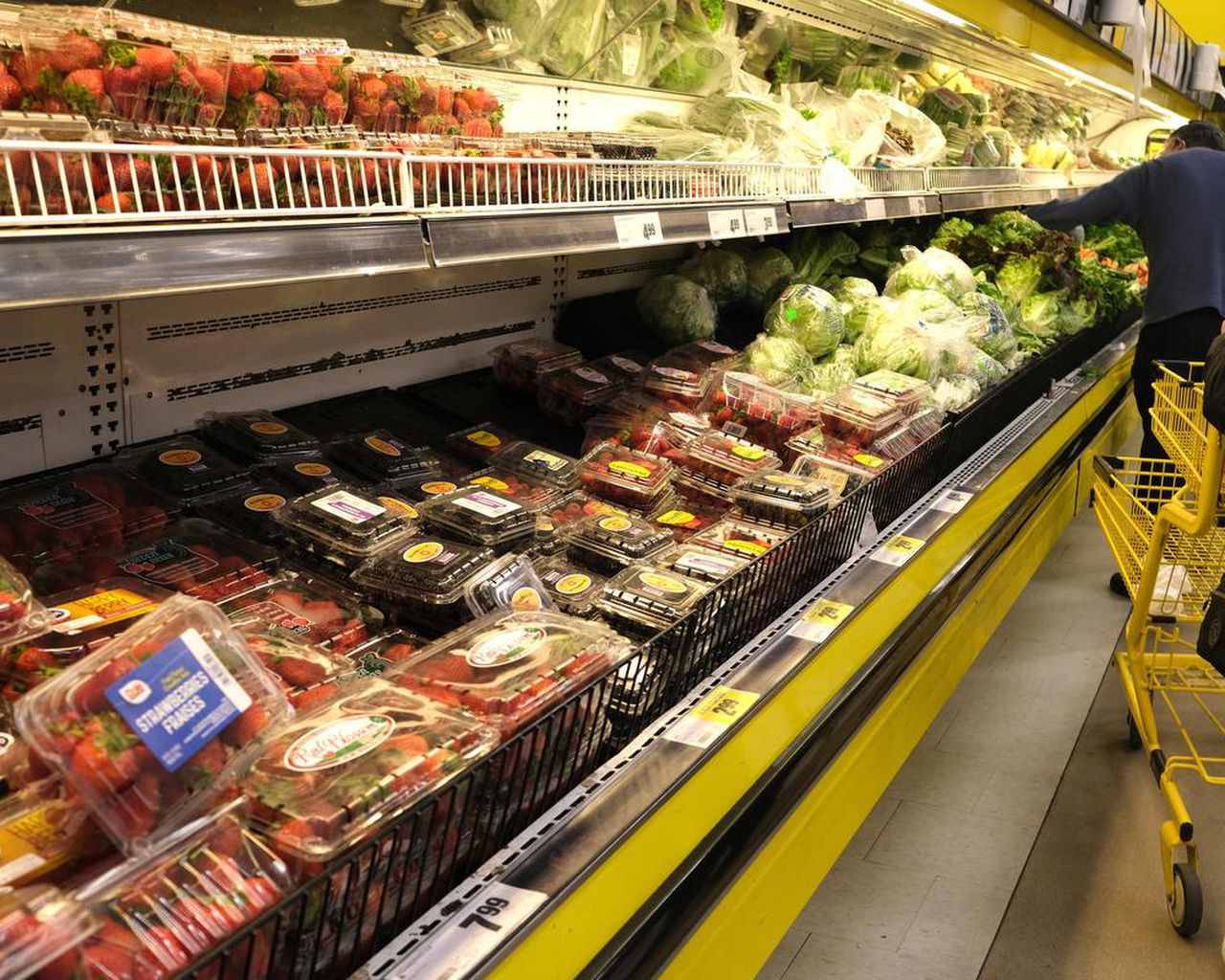Canada's inflation rate fell to two per cent last month, finally hitting the Bank of Canada's target after a tumultuous battle with skyrocketing price growth. The annual inflation rate fell from 2.5 per cent in July to reach the lowest level since February 2021. Statistics Canada's consumer price index report on Tuesday attributed the slowdown in part to lower gasoline prices.
Clothing and footwear prices also decreased on a month-over-month basis, marking the first decline in the month of August since 1971 as retailers offered larger discounts to entice shoppers amid slowing demand. The Bank of Canada's preferred core measures of inflation, which strip out volatility in prices, also edged down in August.
The marked slowdown in price growth last month was steeper than the 2.1 per cent annual increase forecasters were expecting ahead of Tuesday's release and will likely spark speculation of a larger interest rate cut next month from the Bank of Canada. "Inflation remains unthreatening and the Bank of Canada should now focus on trying to stimulate the economy and halting the upward climb in the unemployment rate," wrote CIBC senior economist Andrew Grantham.
Benjamin Reitzes, managing director of Canadian rates and macro strategist at BMO, said Tuesday's figures "tilt the scales" slightly in favour of more aggressive cuts, though he noted the Bank of Canada will have one more inflation reading before its October rate announcement. "If we get another big downside surprise, calls for a 50 basis-point cut will only grow louder," wrote Reitzes in a client note.
The central bank began rapidly hiking interest rates in March 2022 in response to runaway inflation, which peaked at a whopping 8.1 per cent that summer. The central bank increased its key lending rate to five per cent and held it at that level until June 2024, when it delivered its first rate cut in four years. A combination of recovered global supply chains and high interest rates have helped cool price growth in Canada and around the world.
Bank of Canada governor Tiff Macklem recently signalled that the central bank is ready to increase the size of its interest rate cuts, if inflation or the economy slow by more than expected. Its key lending rate currently stands at 4.25 per cent. CIBC is forecasting the central bank will cut its key rate by two percentage points between now and the middle of next year.
The U.S. Federal Reserve is also expected on Wednesday to deliver its first interest rate cut in four years. Today’s softer-than-expected inflation number sparked an immediately downturn in the Canadian dollar and has money markets maintaining their bets that another rate cut looms at the next Bank of Canada meeting Oct. 23 - but there’s considerable uncertainty as to how much.
The Canadian dollar fell to 73.42 cents US as the 830 am ET inflation report was released, from 73.63 prior. Canada’s two-year bond yield eased a little bit - by a couple basis points. That’s relatively stable, and may have also been influenced by a stronger-than-expected U.S. retail sales report released at the same time.
The swaps market, which captures market bets on future monetary policy moves, suggests roughly 50/50 odds on whether it will be a 25 or 50 basis point cut by the BoC on Oct. 23, according to LSEG data.
Regardless, almost 75 basis points of rate cuts are priced into the market by the end of this year. By December of next year, the overnight rate is seen by markets as reaching 2 per cent.
Canada’s annual inflation rate reached the central bank’s target in August at it cooled to 2%, its lowest level since February 2021. The closely watched core price measures also cooled to their lowest level in 40 months while month-on-month consumer prices deflated by 0.2%. Analysts had forecast the consumer price index to cool to 2.1% from 2.5% in July on an annual basis, and expected it to be unchanged on a monthly basis.
Here’s how implied probabilities of future interest rate moves stand in swaps markets, according to data from LSEG moments after the data were released. The overnight rate now resides at 4.25%. While the bank moves in quarter point increments, credit market implied rates fluctuate more fluidly and are constantly changing. Columns to the right are percentage probabilities of future rate moves.
And here’s how interest rate probabilities looked just prior to today’s decision:
Overall, market positioning hasn’t shifted much. But one thing is clear: aggressive monetary easing is widely expected by both markets and economists in the months ahead. Here’s how economists and market strategists are reacting in written statements following the data release:
Royce Mendes, managing director and head of macro strategy at Desjardins
Inflation has been brought to heel in Canada and it’s time for monetary policymakers to make a bigger splash. Headline prices stagnated in August, meaning the annual rate slowed from 2.5% in July to 2.0% in the latest report. That’s the coolest inflation reading since February 2021. Falling energy prices were a major driver of the deceleration, with gasoline down 2.6% on the month and 5.1% over the past year. Total inflation is now tracking materially below the Bank of Canada’s last forecast.
Excluding food and energy, prices were up just 0.1% for a second month in a row in seasonally-adjusted terms. Clothing prices were extremely soft as retailers were forced to offer more and larger discounts to entice spending. Shelter prices rebounded from a welcome slowdown in July on a significant reacceleration of rent inflation. Shelter prices remain a sore spot, but that won’t stop officials from becoming more aggressive. Indeed, the share of categories with prices rising above 3% per year fell to 27% from 30%, which is below the long-term average.
The average of the Bank of Canada’s two preferred core measures decelerated to 2.4%, indicating there’s some downside risk to the central bank’s recent core inflation forecast. The average of the three-month annualized rates also decelerated to 2.4% from 2.8% in the prior month. Moreover, the average of our bias-adjusted core median and trimmed mean metrics declined to 2.1% from 2.3% in July. Core services excluding shelter inflation also slowed to 2.5% from 2.8% in July.
Now that inflation is back to target, it’s time for the Bank of Canada to accelerate the pace of rate cuts. We expect central bankers to slash their policy rate by 50 basis points next month in an effort expedite the return to a more neutral setting. The market is still only placing a 50% probability on a non-standard reduction in October, but there’s no reason to wait for December after seeing these numbers. We expect market pricing to move further in the coming days after the Fed is out of the way.
Derek Holt, head of capital markets economics, Scotiabank
Upsizing on the back of this data would be a policy misstep in my view. That’s because Canadian core inflation picked up again in August over July by contrast to headlines that shouted with glee that the year-over-year headline CPI inflation rate has fallen back to 2%.
The BoC targets headline inflation of 2% over the medium-term but uses its core gauges in higher frequency fashion to operationalize the likely, durable achievement of this mandate. It’s unclear that underlying inflation has cooled fast enough to durably hit 2% headline inflation. Pre-judging this by accelerating easing is among the risks that could reignite inflationary pressure especially with ongoing evidence that a key part of the basket remains hot (shelter) and could become hotter yet.
Key here is to look at the BoC’s preferred core inflation gauges in month-over-month terms at a seasonally adjusted and annualized rate. On that basis, weighted median CPI was up 2.9% and trimmed mean CPI was up 2.3% for an average of 2.6%. That’s not ripping hot like the past, but it suggests that underlying inflationary pressures remain.
Stephen Brown, deputy chief North America economist, Capital Economics
The return of headline inflation to the 2.0% target in August was mainly due to favourable base effects and will be brief, with inflation set to rise back to 2.5% in the fourth quarter. Nonetheless, the details of August release provide further evidence that the inflation battle is almost won, and will serve to increase speculation that the Bank might soon cut by a larger 50bp. ....
Both headline and core inflation are now on track to average 0.1% less than the Bank anticipated this quarter. That alone will not be enough to persuade the Bank to cut by 50bp at its next meeting, but it would leave the door open to a larger move if the Bank becomes more concerned about the downside risks to the economic outlook.
Andrew Grantham, senior economist with CIBC Economics
While the increase in mortgage interest costs continued to ease, it remained the largest contributor to the overall CPI increase on a year-over-year basis. Indeed, excluding MIC, inflation was a mere 1.2% y/y in August. As well as lower gasoline prices, clothing & footwear prices also fell on the month, which Statistics Canada noted was atypical for August which typically sees increases due to back-to-school shopping. Partly because of this, core measures of inflation remained tame with seasonally adjusted ex food/energy prices increasing 0.1%, and CPI-trim and CPI-median both advancing 0.2% m/m. With gasoline prices falling further into September, headline inflation should ease again in the next release and CPI excluding MIC could well fall below 1%. The bottom line then is that inflation remains unthreatening and the Bank of Canada should now focus on trying to stimulate the economy and halting the upward climb in the unemployment rate. We continue to forecast a further 200bp of interest rate cuts between now and the middle of next year.
David Rosenberg, founder of Rosenberg Research
In the wake of this CPI report, swap markets are now pricing 50/50 odds that the Bank of Canada will cut rates by 50 basis points in October rather than by 25. There is still a long way to go to that meeting, and much will depend on the Fed’s actions tomorrow and the subsequent data flow. But the complete lack of any inflationary concerns at a time when the labor market is cracking up like an April ice sheet makes the case for a more aggressive easing policy very persuasive. On our estimates, the BoC is already around 200 basis points behind the growth/inflation curve. Why delay?
Philip Petursson, chief investment strategist at IG Wealth Management
Let’s call it, inflation is done. With inflation at 2% the Bank of Canada has succeeded in its effort to bring in the Covid-era inflation back to within the Bank’s target range. The lower inflation for the month of August had more to do with the price of oil and gas falling than anything else. Excluding energy, inflation gained 2.5% year-over-year. Nonetheless, the Bank of Canada can close the book on inflation, for now and turn its focus to the struggling labour market. Looking deeper into the report we see a couple of key takeaways. First, the more significant contributor to inflation continues to be shelter costs. Excluding shelter, inflation was virtually non-existent in Canada year-over-year. As the BoC continues to cut its overnight rate, and as those cuts continue to roll into mortgage rates, shelter costs will continue to fall. This is more a 2025 story than a 2024 story, but one the Bank can use as a reason to solidify its easing strategy with expectations that inflation will remain firmly within its target range. The other takeaway is that restaurant inflation grew at a faster rate than the broader measure. This may become an area of economic weakness if consumers that for now are allocating more to shelter costs tighten up their spending and shift away from restaurants. Overall, this was a report that the Bank of Canada should take as continued reason to cut its overnight rate in each of the remaining meetings this year by 25 bps if not 50. The Bank of Canada is on the path to an overnight rate of 2.5% before the end of 2025.
Benjamin Reitzes, managing director, Canadian rates and macro strategist, BMO Capital Markets
The weaker headline reading, with inflation finally back to the 2% target for the first time in over three years, will reinforce expectations for the Bank of Canada to cut rates further. The question markets are grappling with is whether the next move will be 25 bps or 50 bps. The BoC has highlighted that downside growth risks are a key concern, suggesting that next week’s GDP figures loom large in the 25 vs 50 debate. Today’s figure tilts the scales a touch toward a more aggressive path, but there’s still another CPI report before the next meeting. If we get another big downside surprise, calls for a 50 bp cut will only grow louder.
James Orlando, director and senior economist, TD Economics
Bullseye! Headline inflation is back at the Bank of Canada’s 2.0% target. At the same time, core measures keep grinding lower. These figures would be even lower if it weren’t for the outsized impact of high housing costs. Inflation excluding shelter is growing at a paltry 0.5% y/y! This exemplifies how still high interest rates have weighed on the Canadian economy and slowed the pace of growth.
Inflation continues to validate the need for the Bank of Canada to continue cutting its policy rate. We calculate that the current policy rate is still nearly 200 basis points above where it should be based on the current state of the economy. And that is after 75 bps in cuts over the last few months. No wonder odds of larger 50 basis point cuts are growing in futures markets. Over the next few weeks, we will be getting a number of BoC members speaking on the economy. This will provide the central bank plenty of opportunity to move market pricing towards its intended path.
Tu Nguyen, economist with assurance, tax & consultancy firm RSM Canada
While the return to 2% inflation raises the odds of a larger sized cut, the Bank of Canada is likely to continue with the slow and gradual approach of a 25 basis point rate cut in October, with a possibility of another 25 basis point cut in December.
Two 25-basis point cuts will be favoured over a single 50 basis point cut, because a larger cut could cause prospective buyers to rush into the housing market and home prices to shoot up.
Excluding gasoline, prices rose 2.2% in August. All core measures of inflation also dropped, suggesting that disinflation is a solid trend that is here to stay.
South of the border, the Federal Reserve is expected to announce its first rate cut tomorrow, which will help keep the two central banks’ policy rates from diverging too much. That said, the anticipated decrease in the value of the Canadian dollar from rate divergence had not materialized.
The Fed’s decision will likely not affect the Canadian dollar too much, but the rate cut cycle occurring in both countries could help spark investments among Canadian businesses.
Nick Rees, senior FX market analyst, Monex Canada
Canadian inflation continues to soften, and soften faster than expected, reinforcing calls for the BoC to up the pace of easing to 50bp increments. Headline price growth is now tracking at 2.0% YoY, in line with the BoC’s price growth target, a full 0.5% lower than in July. In fact, aggregate prices fell outright last month, dropping -0.2%, having been expected to grow 0.1% MoM. Underlying inflation measures also continue to ease, highlighting fading upside risks. While we stick with our call for the BoC to ease in 25bp increments, matching the pace we expect from the Fed, the case for faster BoC rate cuts is clearly growing, posing upside risks for CAD.
If any more evidence was needed that the BoC has successfully contained inflation pressures, the finer details of today’s CPI report have it in spades. Looking at the BoC’s preferred measures for underlying price growth, core median CPI growth fell from 2.4% YoY to 2.3%, while core trim CPI fell from 2.7% to just 2.4%. Indeed, our own preferred measures of underlying inflation pressure are more troubling. Core PCI ex-shelter is now just 0.35% YoY. CPI excluding mortgage and rent costs, meanwhile, fell from 0.85% YoY in July to just 0.30% in August. Perhaps most alarmingly to us, inflation momentum on both measures turned negative last month, having previously been tracking above 3% across both measures on a 3mma annualised basis. If anything, this suggests the BoC has done more than just cool inflation - they might have killed it, a development that should be cause for growing concern amongst the Governing Council.
Indeed, almost all Canadian price growth is now attributable to shelter components. And these should not worry policymakers. Slower population growth due to lower immigration, rate cuts, and the lagged effects of policy tightening all point to further disinflation for shelter costs in the pipeline. Instead, with headline inflation back to target and growing signs of a slowdown below the surface, there is an increasingly strong case for the BoC to accelerate the pace of rate cuts. Admittedly, for now, we continue to look for consecutive 25bps cuts from the Governing Council. As we see it the optics of accelerating the pace of easing remain unfavourable, provided the Fed fails to ease by 50bps tomorrow, meeting our expectations or a 25bp cut. That said, a dovish Fed surprise or a further slowdown across other data readings could well see a 50bp BoC rate cut become the base case ahead of October’s rate decision, entailing downside risks for the loonie over the coming months.
Nathan Janzen and Abbey Xu, economists with Royal Bank of Canada
Broader inflation pressures look to be back around the 2% inflation target, and interest rates are still at levels high enough to restrict economic growth and push price growth lower. Per-capita GDP already down in 7 of the last 8 quarters and the unemployment rate up more than a percent from a year ago. Against that backdrop, the path to further BoC interest rate cuts is clear. We continue to expect a gradual rate cutting path (25 basis points per meeting) down to a 3% overnight rate with risks tilted to potentially larger cuts if the economy softens significantly further.



















